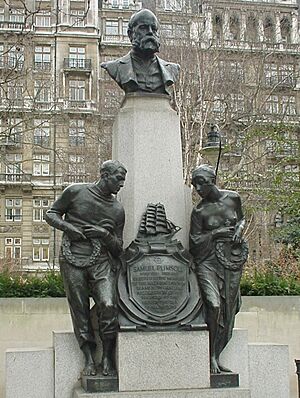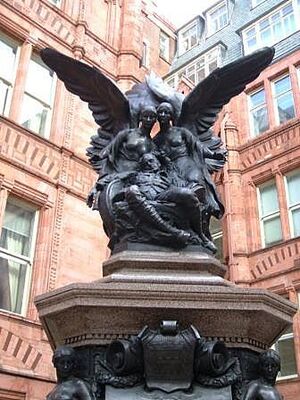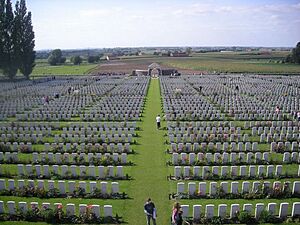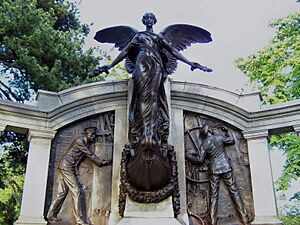Ferdinand Victor Blundstone facts for kids
Quick facts for kids
Ferdinand Victor Blundstone
|
|
|---|---|
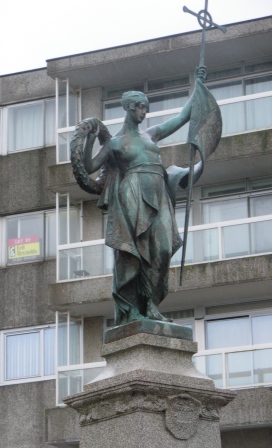
|
|
| Born | 1882 Switzerland
|
| Died | 1951 |
| Education | South London Technical Art School, Royal Academy Schools |
| Known for | Sculpture |
Ferdinand Victor Blundstone (1882–1951) was a talented sculptor born in Switzerland. He spent most of his working life in England, creating many beautiful and important sculptures. His father, Charles Blundstone, was a merchant from Manchester, England. Ferdinand studied art at some of the best schools in London, where he won several awards for his amazing work.
After a big war called the Great War (now known as World War I), Blundstone became famous for making several war memorials. These special sculptures help us remember the brave soldiers who fought and gave their lives. One of his most well-known memorials is the Folkestone War Memorial.
Contents
Becoming a Sculptor
Ferdinand Blundstone loved art from a young age. He first studied at the Ashton-under-Lyne Art School. Later, he went to the South London Technical Art School. His journey continued at the famous Royal Academy Schools.
While at the Royal Academy, Ferdinand won many important awards. In 1904, he received the Landseer Scholarship for one of his sculptures. He also won a second-place prize in 1905 for a model he created. Two years later, in 1907, he earned another Landseer Scholarship. That same year, he won a special traveling scholarship worth £200 and a gold medal, which showed how talented he was.
Where He Lived
Around 1908, Blundstone lived in Manchester. During World War I, he might have lived with his family in Heaton Chapel, a part of Greater Manchester. From about 1919 until he passed away in 1951, London was his home. He had several art studios in London where he created his sculptures.
Famous Sculptures and Memorials
Ferdinand Blundstone created many different types of sculptures, including portraits and large memorials. Here are some of his most notable works:
War Memorials and Public Art
Folkestone War Memorial
The Folkestone War Memorial is located in Folkestone, Kent. It was officially revealed on December 1, 1922. This memorial features a bronze figure of "Motherhood." She holds a pole with a flag at half-mast and a cross, while raising a victory laurel in her other hand. She sits on a stone base.
The memorial has a special message carved into it:
"TO OUR GLORIOUS DEAD / MAY THESE/DEEDS BE / HELD IN / REVERENCE"
Folkestone was a very important place during World War I. Millions of soldiers and nurses traveled through Folkestone Harbour Station when going to or returning from the war.
Newfoundland National War Memorial
This huge memorial is in St. John's, Newfoundland. It was unveiled on July 1, 1924. At the very top stands a bronze figure representing "Freedom." Four other figures surround this central statue. Blundstone was responsible for creating these bronze figures at the top and on the sides of the memorial.
The Plimsoll Line Memorial
This memorial stands in London, near the Victoria Embankment. Blundstone was asked to create it by the National Union of Seamen. It was unveiled on August 21, 1929. The memorial thanks Samuel Plimsoll for his efforts to create the "Plimsoll Load Line." This line, marked on ships, prevents them from being overloaded, making sea travel much safer. Plimsoll was known as "the Sailors' Friend." The sculpture shows "Justice" as a woman, alongside a seaman, both holding wreaths.
The Prudential War Memorial
In Holborn, London, Blundstone created a memorial in 1922. It remembers the employees of Prudential Assurance who died in the First World War. There is another memorial nearby for those who died in the 1939–1945 conflict (World War II).
The Stalybridge War Memorial
This memorial in Stalybridge, Cheshire, was unveiled on November 10, 1920. Blundstone created the bronze groups of dying soldiers and sailors being comforted by angels.
Tyne Cot Memorial
The Tyne Cot Memorial is part of a very large First World War cemetery in Belgium. This cemetery has nearly 12,000 graves. The memorial lists the names of 34,888 soldiers who went missing or died without a known grave. Blundstone and another sculptor, John Armitage, were responsible for all the decorative sculptures on this memorial.
Titanic Engineers' Memorial
In Andrew's Park, Southampton, Blundstone created a memorial made of granite. It was paid for by donations from engineers around the world. This memorial honors the engineers of the Titanic ship who died when it sank. The memorial features a figure called Glory, reaching out with a laurel wreath to the struggling men in the Titanic's engine room. It was unveiled on April 22, 1914.
Other Notable Works
- Figure of Diana: This bronze sculpture shows Diana, a goddess, with a fawn and a gazelle. It sits on a green marble base and is signed by Blundstone.
- Gnome Monument, Bowring Park: Blundstone created the "Gnome" Monument on top of the Connaught Stone in St. John's, Newfoundland.
- Lewis Carroll majolica panels: He made special ceramic panels for the Lewis Carroll Memorial Ward at St Mary's Hospital in Paddington, London.
- Wendy statue (Peter Pan): This sculpture, one of his last works, was made for King Edward Park in Hāwera, New Zealand. It was completed with help from another sculptor, Gilbert Bayes.
Professional Groups
Ferdinand Blundstone was part of several important professional groups for artists:
- From 1919 to 1951, he was a member of the Royal Society of British Sculptors.
- He served on the council of the Royal Society of British Sculptors from 1921 to 1923, and again from 1935 to 1936.
- From 1924 to 1931, he was a member of the Art Workers Guild.
- From 1926 until his death in 1951, he was a Fellow of the Royal Society of British Sculptors.
Exhibitions and Awards
Blundstone's sculptures were shown in many exhibitions. These included portraits, statues, trophies, and war memorials.
- In 1903, his work Tiger at Bay was shown in Manchester.
- In 1907, Jacob Wrestling with the Angel was also shown in Manchester.
- He exhibited many times at The Exhibition of the Royal Academy of Arts (Summer Exhibition) between 1907 and 1944.
- In 1925, he won a silver medal at the Paris Exhibition for one of his garden sculptures.
He also participated in several competitions:
- He won the Landseer Scholarships at the Royal Academy of Arts in both 1904 and 1907.
- In 1920, he won the competition to design the Folkestone Memorial.
Images for kids


